Star Wars: Jedi Challenges Review: The AR Force Is Strong
- Finally, a "real" lightsaber
- Affordable, with great build-quality
- AR graphics flatter the Star Wars universe
- Single-player only (for now)
- AR lightsaber blade can drift
- Currently limited to one Star Wars app only
Is there a science-fiction franchise more ripe for an augmented reality game than Star Wars? Disney and Lenovo don't think so, hence Star Wars: Jedi Challenges, a new gaming system that promises lightsaber battles, Holochess, and more in your own home, powered by your smartphone. Affordable VR has had its tipping point; now, it's time for AR to do the same.
The Star Wars: Jedi Challenges system isn't the first augmented reality system we've seen, but it's probably the most inexpensive. Compared to, say, Microsoft's HoloLens, Lenovo's $199.99 headset is a fraction of the price. Then again, even the company and partner Disney are upfront about this not being the be-all and end-all in enterprise-grade graphics. The goal here is affordable fun.
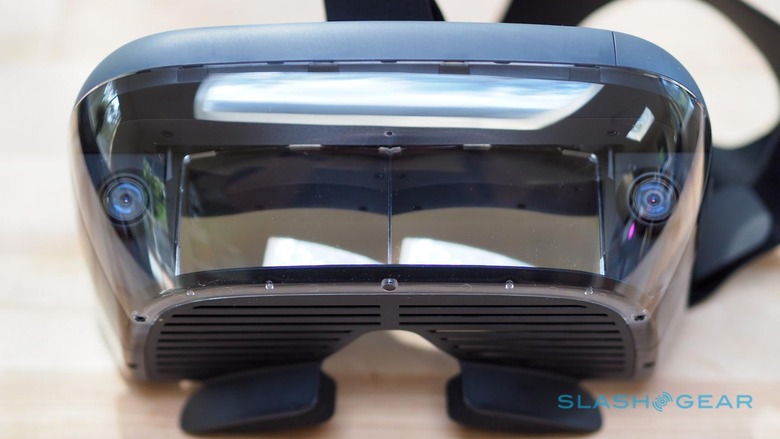
The headset – Lenovo is calling it the AR Mirage – weighs just over a pound, and has three adjustable straps to fit over your head. It recharges via microUSB, and has three controls on the side: menu, select, and cancel. Courtesy of the light weight and the cushioned pads, it's comfortable enough for extended sessions.
It's a fairly clever system. Like Daydream, Gear VR, and other phone-based headsets, Jedi Challenges relies on your smartphone being slotted inside and donating its display; the AR Mirage also uses its speakers, too. Unlike those virtual reality systems, however, the phone isn't directly in front of you.
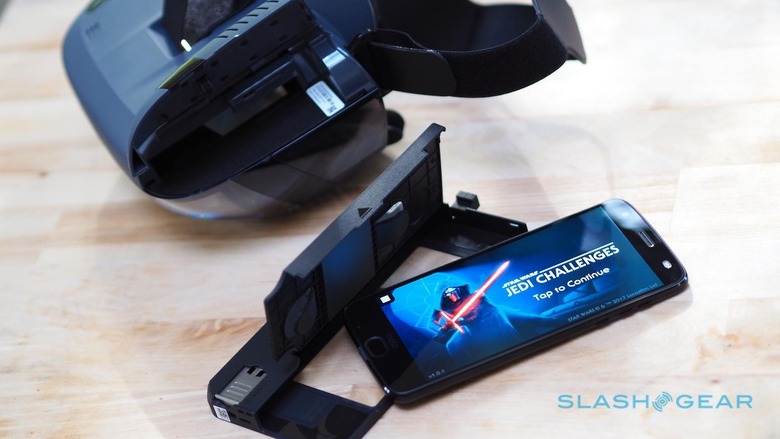
Instead, it's orientated horizontally, with the display facing down. Two semi-mirrored lenses are in front of your eyes, so that you see not only the view ahead but a reflection of what's on the phone's screen. The result is a HoloLens-like augmented reality experience, but without expensive transparent displays and an impressive 33-degree field of view vertically and 60-degrees horizontally.
I suspect that, were it anything other than Star Wars, the quality of the augmented reality graphics might come in for some criticism. The digital overlay is somewhat ghostly, a true hologram appearance rather than objects that look solid. That, of course, matches the holographic projections in the Star Wars movies, which are themselves somewhat crunchy and glitchy.
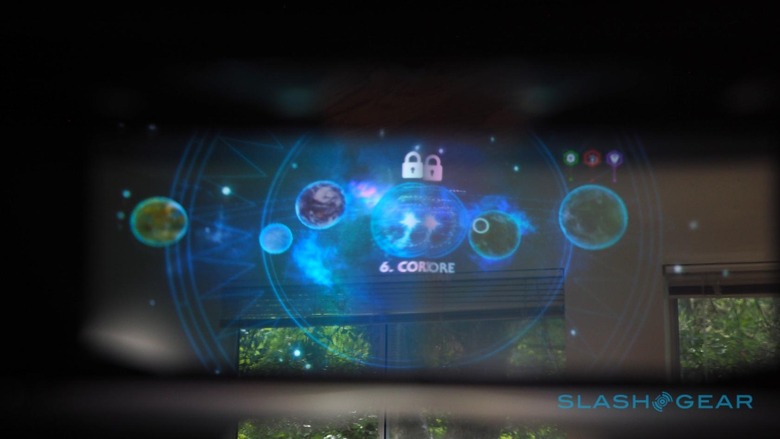
Currently, there's support for the iPhone 6 through 8, the Google Pixel and Pixel XL, LG G6, Moto Z2 Force, and Samsung's Galaxy S7, S7 edge, and S8. Lenovo tells me there'll be further devices added to that list over time. The tray into which you slot the phone has adjustable grips to keep it from sliding around; there are three short cables – for microUSB, USB-C, and Lightning – to connect the phone to the headset itself.
For positioning, the headset uses a pair of cameras with fisheye lenses, which track both the illuminated tip of the lightsaber and the glowing beacon that you put on the floor. In addition, the lightsaber pairs with the phone via Bluetooth, sharing its gyroscope and accelerometer data, as well as button-presses.
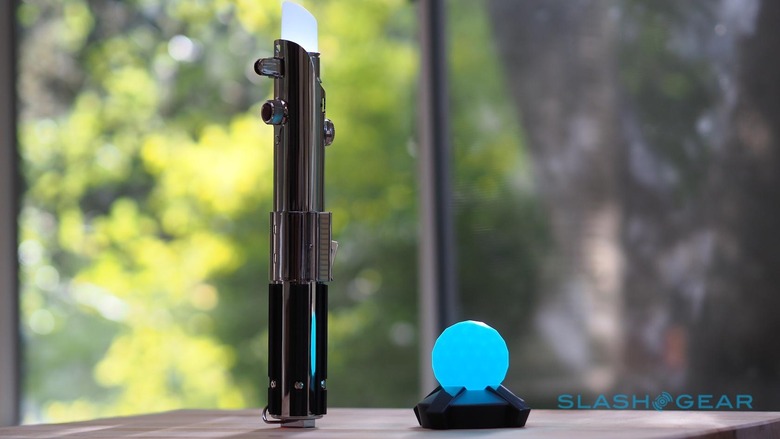
The lightsaber is undoubtedly the star of the show. It's an impressively accurate replica of the iconic weapon used by Anakin, Luke, and Rey in the Star Wars movies, and recharges via microUSB. Honestly, I think its quality could've been the make-it-or-break-it factor of the whole system: had it been plasticky and felt cheap, a lot of the charm would've evaporated when you picked it up. Instead, at over a foot long and more than half a pound in weight, it has a pleasing heft and the metal construction feels like it could actually withstand a battle.

Once you've walked through the setup guide and donned the headset, the interface is a star map of the Galaxy. There are six planets – Naboo, Garel, Lothal, Hoth, Takodana, and The Core – with each having a different set of challenges spanning multiple difficulties, and with a variety of characters from the movies. Your own progress is from Padawan through to Master Jedi, guided by the in-game tutor, the Archivist.
Out of the box, there are three main types of challenge. What I suspect most people will gravitate toward are the lightsaber battles, which vary from fighting waves of smart-talking battle droids through to Kylo Ren and Darth Vader. Gameplay itself involves not only swiping at enemies but blocking or dodging their attacks; if droids are firing at you, you can bounce their their energy bolts back at them.
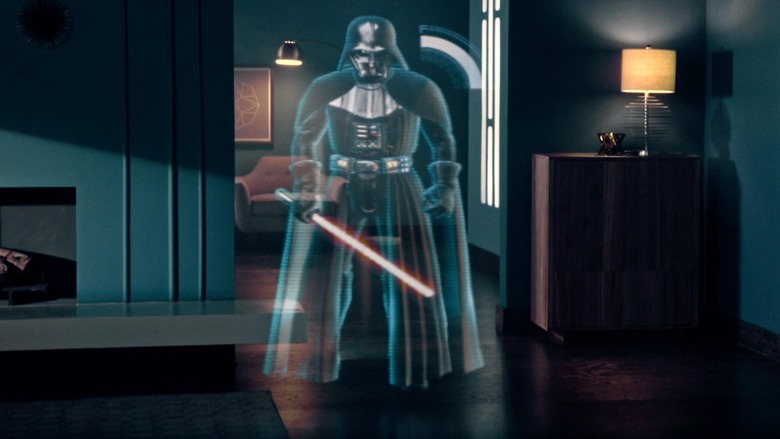
In the one-on-one battles, meanwhile, the headset overlays a yellow guide for how to block each of your opponent's strikes. It can become quite a frenetic affair if you so choose, and I'm told the system takes into account the strength at which you swing, though time it right and you can match the right angles and then counter-strike with very little movement indeed.
After an extended play, I did find that the alignment between the physical lightsaber and the AR blade could drift: I'd hold the lightsaber out straight, but the blade would be skewed. Pressing a button on the handle resets it straight again. Even with that interrupting play occasionally, the combination of the convincing sound effects and short, punchy rounds of fighting are enough to keep you engaged.
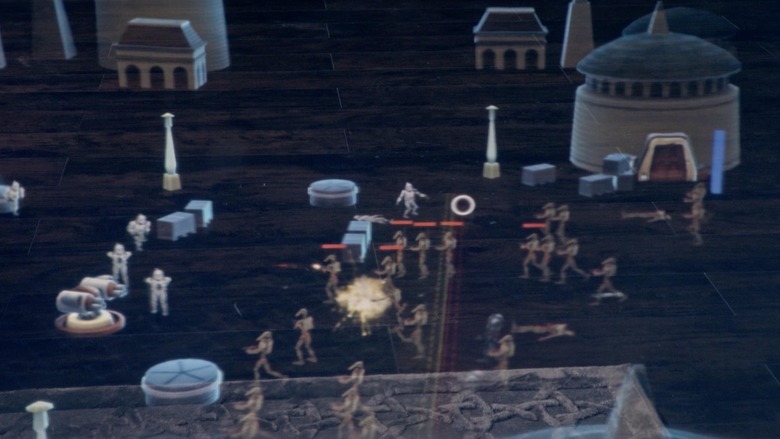
It's all good fun, but I actually preferred the other two challenge types. In strategic combat, your floor or table is turned into a battle arena, full of miniature warriors, buildings, laser turrets, and vehicles from the movies. You're expected to take the role of Jedi General, deploying troops and weapons to hold off waves of AT-ATs and more. Being able to get down on the floor and get on the same level as dozens of brawling characters is surprisingly entertaining; later on, you can fly an X-wing through the battle arena, guiding it with your lightsaber.
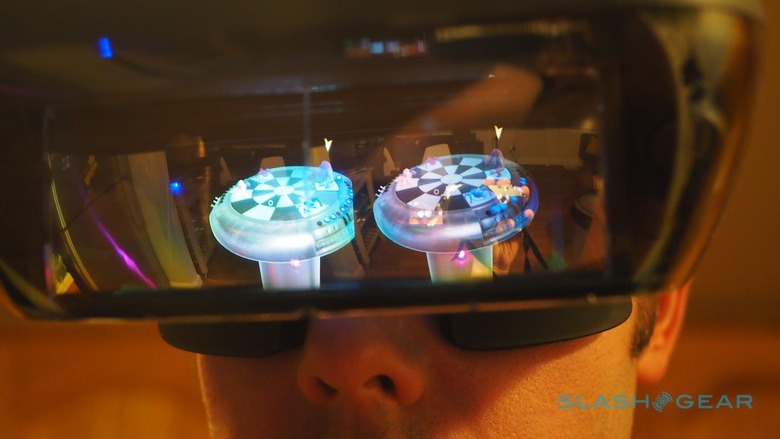
The last challenge is maybe the most instantly recognizable: the Holochess from the Millennium Falcon in Star Wars: Episode IV – A New Hope. Eight different characters play across a circular board, each with their own moves, strengths, and weaknesses, and you have to figure out how best to deploy them so that they don't get crushed or bludgeoned to death.
Unfortunately, actually sharing that experience is difficult. Currently, Jedi Challenges is a one-player affair, though Disney tells me that it's working on multiplayer – then, hopefully, you and a friend will be able to battle with lightsabers or take each other on in Holochess, rather than just fighting against virtual enemies. I'd have liked to have seen some sort of screen-sharing option, beaming what the headset-wearer is seeing to a nearby TV so that observers can admire their saber-wielding as well as laugh at them lunging around the room.
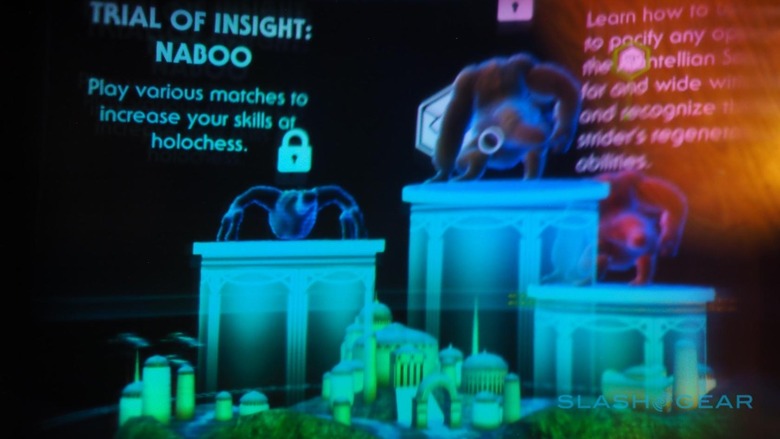
According to Disney's testing, there's around twelve hours of gameplay from start to finish. Obviously, that depends on how adept you are and how much time you put into each challenge. If you're a completionist, and want to check all the boxes you can, expect it to take you even longer. Of course, you can go back and re-play any of the challenges you want to.
Down the line, Disney plans to add more games through updates to the Jedi Challenges app. They won't tell me what they're working on, but the Star Wars universe is rich pickings for possibilities which gives me hope for the longevity of the system overall.
Wrap-up
When I first put on the AR Mirage headset, I expected a gimmick. The reality, though, is that Star Wars: Jedi Challenges is surprisingly good fun, as long as you can shed your inhibitions some and get into the swing of things – literally. The games are easy to pick up, even if you're neither a die-hard Star Wars fan nor a regular gamer.

As the start of a broader AR platform, I'm not quite so convinced. Lenovo's phone-based system suits the Star Wars aesthetic well, but step outside that design language and the ghost-like graphics may not be so well-received. Right now, mind, that's a moot point, since there's no talk of anything but more Star Wars games in the pipeline.
At $199.99, Star Wars: Jedi Challenges doesn't break the bank, and there's legitimate fun to be had whether you're playing yourself or watching someone flail around. More collaborative features would bolster that latter experience: then, I could see it being a popular party game at the holidays. For now, though, this is about as close to a real, working lightsaber as you can get, and without the risk of losing a hand.
